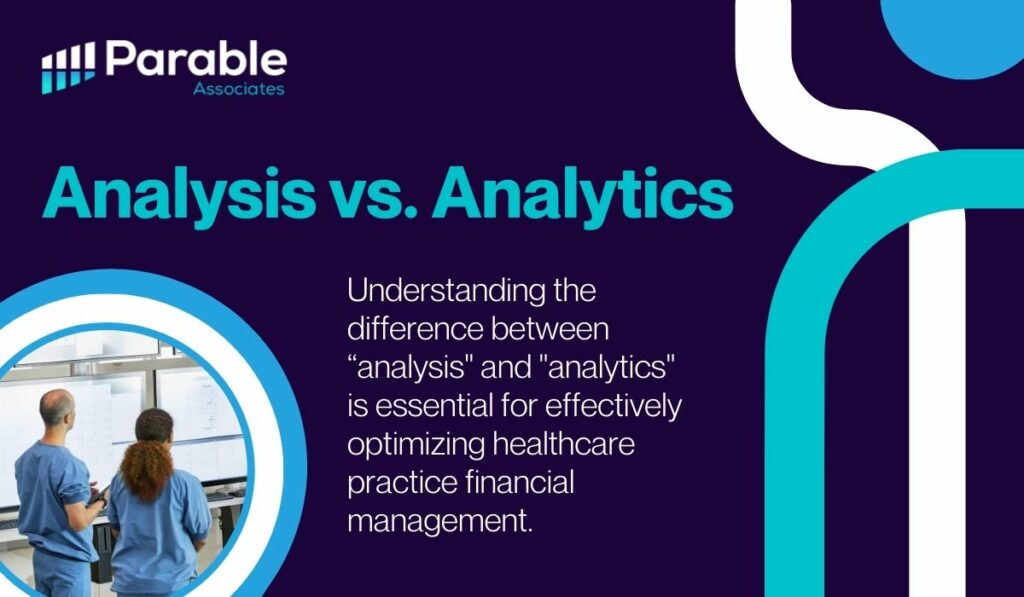Revenue cycle management (RCM) is essential to have a successful and profitable healthcare practice. It encompasses all financial tasks from scheduling appointments to collecting payments. Effective RCM ensures that healthcare providers are compensated for their services in a timely and accurate manner. In an increasingly complex healthcare environment, analytics have emerged as a powerful tool to accelerate the revenue cycle. By leveraging data-driven insights, practices can significantly improve their profitability and overall financial health. However, the terms revenue cycle analytics and revenue cycle analysis are often thought to mean the same thing. Before we focus on improving your bottom line, let’s clear up the confusion.

Analysis vs. Analytics
While “revenue cycle analysis” and “revenue cycle analytics” are often used interchangeably in the context of healthcare financial management, they refer to different aspects of the process. Understanding the distinction between these terms is crucial for effectively managing and optimizing a healthcare practice’s revenue cycle.
Revenue Cycle Analysis
Analysis of the revenue cycle involves a thorough examination of the financial processes related to practice operations. This includes reviewing the entire cycle from patient registration to final payment collection.
Key Focus Areas
- Process Evaluation: Identifying inefficiencies and bottlenecks in the current revenue cycle processes.
- Performance Assessment: Evaluating the effectiveness of existing financial workflows and systems.
- Problem Identification: Detecting specific issues such as frequent claim denials, delays in billing, and underpayments.
- Strategic Planning: Developing strategies to address identified problems and improve overall financial performance.
The primary goal of revenue cycle analysis is to provide a detailed understanding of the current state of financial operations. It aims to uncover issues and devise actionable plans to enhance the efficiency and effectiveness of the revenue cycle.
Revenue Cycle Analytics
Revenue cycle analytics refers to the use of advanced data analysis tools and techniques to monitor, evaluate, and improve the revenue cycle. It involves applying statistical models, algorithms, and predictive analytics to financial data.
Key Focus Areas
- Data Collection and Integration: Aggregating data from various sources such as electronic health records (EHR), billing systems, and payment processors.
- Real-Time Monitoring: Continuously tracking key performance indicators (KPIs) such as days in accounts receivable (AR), clean claim rate, and denial rate.
- Predictive Analytics: Using historical data to forecast future trends, such as patient admission rates and potential revenue shortfalls.
- Visualization and Reporting: Creating dashboards, charts, and reports that provide clear and actionable insights into the revenue cycle.
The primary goal of revenue cycle analytics is to leverage data to drive decision-making and continuous improvement. It focuses on providing real-time insights and predictive capabilities to proactively manage and optimize the revenue cycle.
Key Differences
Revenue cycle analysis is primarily retrospective, focusing on reviewing and assessing existing financial processes and performance. It involves manual review and evaluation, providing a detailed assessment of current operations and identifying specific areas for improvement through traditional methods such as process mapping, performance reviews, and strategic planning.
In contrast, revenue cycle analytics is both retrospective and prospective, concentrating on real-time monitoring and future predictions to optimize the revenue cycle. It utilizes automated data collection, statistical analysis, and advanced software tools for continuous monitoring and improvement. Revenue cycle analytics offers ongoing insights and predictive models, enabling healthcare providers to make informed decisions and continuously enhance financial performance through the use of data visualization tools, machine learning algorithms, and predictive analytics platforms.

Revenue Cycle Key Metrics
Days in Accounts Receivable (AR)
This is an extremely important metric that measures the average number of days it takes for a practice to receive payment after a service is provided. A high number of days in AR can indicate inefficiencies in the billing and collections process. To reduce days in AR, practices can implement strategies such as improving claim accuracy, following up on unpaid claims promptly, and offering flexible payment options to patients. Reducing days in AR helps improve cash flow and financial stability.
Clean Claim Rate
The clean claim rate is the percentage of claims submitted without errors that require correction or resubmission. A high clean claim rate indicates that the practice’s billing processes are efficient and accurate. To improve the clean claim rate, practices can invest in training for billing staff, implement automated billing systems, and conduct regular audits to identify and address common errors. Improving the clean claim rate reduces the administrative burden associated with reworking claims and accelerates the reimbursement process.
Denial Rate
This refers to the percentage of claims that are denied by payers. A high denial rate can significantly impact a practice’s revenue and cash flow. To reduce the denial rate, practices can analyze the reasons for claim denials and implement corrective actions, such as improving documentation practices, verifying patient insurance information upfront, and ensuring accurate coding. By addressing the root causes of denials, practices can increase their clean claim rate and enhance overall financial performance.
Net Collection Rate
The net collection rate measures the percentage of allowable charges collected out of the total charges billed. A high net collection rate indicates that the practice is effectively collecting payments for the services provided. To maximize the net collection rate, practices can implement strategies such as timely follow-up on unpaid claims, offering payment plans to patients, and negotiating favorable contracts with payers. Maximizing the net collection rate ensures that the practice receives the full revenue it is entitled to.
Patient Payment Rate
The patient payment rate is the percentage of patient-responsible balances that are collected. Improving patient collections is crucial for maintaining a steady revenue stream. Practices can enhance patient payment rates by issuing timely and clear billing statements and offering multiple payment options.
Revenue Cycle Analytics and Business Intelligence
Revenue cycle analytics and business intelligence (BI) are closely intertwined concepts that together create a powerful framework for optimizing healthcare financial management. While revenue cycle analytics focuses specifically on the financial processes associated with patient care, BI encompasses a broader range of data-driven strategies and tools that support decision-making across all aspects of a healthcare practice.
Revenue cycle analytics involves the systematic collection, integration, and analysis of financial data related to the revenue cycle. Business intelligence, on the other hand, provides a comprehensive approach to managing and leveraging data across the entire organization. BI tools aggregate data from various sources, including electronic health records (EHR), patient management systems, and financial databases, to provide a unified view of the practice’s operations.
Integrating revenue cycle analytics within the broader BI framework enhances the ability of healthcare practices to optimize their operations and financial performance. With BI tools, practices can not only monitor and improve revenue cycle metrics but also understand how these financial processes interact with other aspects of the organization. For instance, BI can reveal how clinical workflows impact billing efficiency or how patient satisfaction correlates with payment timeliness.
Benefits of Revenue Cycle Analytics
Increased Revenue
Revenue cycle analytics identify underpayments and claim denials, common issues that lead to losses. By addressing these problems, practices can ensure claims are accurate before submission, reducing denials and increasing revenue. Additionally, analytics reveal trends in payer behavior, aiding in better contract negotiations and optimized billing processes.
Improved Cash Flow
Revenue cycle analytics improve cash flow by streamlining billing processes and speeding up reimbursement cycles, ensuring faster payments. Analytics also enhance patient collections by identifying outstanding balances and implementing targeted collection strategies. This proactive management maintains steady revenue and reduces financial stress.
Operational Efficiency
Automating tasks like data entry and claim submission with analytics tools frees up staff for strategic activities. These tools identify bottlenecks and inefficiencies, optimizing staff productivity and resource use. Analyzing scheduling patterns helps reduce wait times and avoid overbooking, improving both patient experience and operational performance.
Enhanced Decision-Making
Real-time data access and predictive analytics enhance decision-making by providing insights into key performance metrics and trends. Predictive analytics forecast future trends, helping practices plan and allocate resources effectively. This supports strategic planning and keeps practices ahead of potential challenges.
Compliance and Risk Management
Revenue cycle analytics ensure compliance with regulatory requirements and minimize financial and legal risks by providing audit trails and transaction documentation. Analytics tools identify potential risks, like coding errors or unusual billing patterns, allowing practices to address issues proactively, and protecting them from penalties and reputational damage.

Implementing Business Intelligence
Choosing the Right Tools
Selecting the right analytics tools is crucial for successful implementation. Practices should evaluate BI platforms based on user-friendliness, scalability, and customization options. The chosen tool must align with the practice’s needs, providing comprehensive analytics and reporting features to support revenue cycle management. User-friendly interfaces and robust support are essential for staff adoption and long-term success.
Data Integration
Effective data integration from various sources is vital for comprehensive revenue cycle analytics. Healthcare practices often have data spread across EHRs, billing systems, and other applications. Ensuring data quality and consistency is critical for accurate analysis. BI tools must seamlessly integrate diverse data sources to provide a comprehensive view of operations, ensuring reliable and actionable insights.
Training and Adoption
Training is essential for effective revenue cycle analytics implementation. Staff must learn to generate reports, interpret data, and apply insights to decision-making. Promoting a data-driven culture ensures analytics become integral to daily operations. Ongoing training and support keep staff updated with the latest features and best practices, fostering widespread adoption.
Continuous Improvement
Revenue cycle analytics require continuous monitoring and optimization. Practices should regularly review key performance metrics, adjust strategies based on insights, and leverage analytics for ongoing improvements. Continuous refinement of analytics processes helps identify new opportunities for enhancement, ensuring the practice remains agile and responsive to changing conditions. This drives sustained financial performance and operational efficiency.

Ready to Transform Your Practice?
Revenue cycle analytics is a powerful tool that can drive operational success. Parable Associates specializes in implementing tailored BI solutions for healthcare practices. Our expertise in data integration, analytics, and user training ensures that your practice can fully leverage the power of business intelligence. By partnering with us, healthcare practices can unlock the potential of their data, leading to improved operational efficiency, and effective revenue cycle management. Choose Parable Associates for a comprehensive, customized approach to healthcare business intelligence. Schedule a discovery call today to take the first step toward transforming your practice.
Revenue Cycle Analytics FAQs
Revenue cycle management (RCM) encompasses all financial tasks in healthcare practices, from scheduling appointments to collecting payments and ensuring timely and accurate compensation for services provided.
Revenue cycle analysis involves reviewing and assessing existing financial processes, while revenue cycle analytics focuses on real-time monitoring and predictive modeling to optimize the revenue cycle.
Revenue cycle analytics can increase revenue, improve cash flow, enhance operational efficiency, support better decision-making, and ensure compliance with regulatory requirements.
Analytics streamline billing processes and speed up reimbursement cycles, ensuring faster payments. They also enhance patient collections by identifying outstanding balances and implementing targeted strategies.
Key metrics include days in accounts receivable (AR), clean claim rate, denial rate, net collection rate, and patient payment rate. Monitoring these helps practices optimize financial performance
Select BI platforms based on user-friendliness, scalability, and customization options. The chosen tool should align with your practice’s needs and provide comprehensive analytics and reporting features.
Effective data integration ensures that data from various sources, such as EHRs and billing systems, is combined to provide a comprehensive view of operations, ensuring reliable and actionable insights.
Parable Associates specializes in tailored business intelligence solutions for healthcare practices. Our expertise in data integration, analytics, and user training ensures you fully leverage the power of BI for improved operational efficiency and effective revenue cycle management. Partner with Parable Associates to unlock your practice’s data potential and achieve sustainable success. Schedule a discovery call today.

